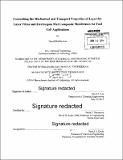| dc.description.abstract | There is an ever increasing need for clean, portable energy devices, such as fuel cells and high energy batteries to replace or reduce the world's dependence on fossil fuels. The continued development of thin-film solid polymer electrolytes with improved mechanical and ion transport properties is critical for the further advancement of such electrochemical energy devices. For hydrogen and methanol fuel cells, the proton exchange membrane (PEM) has to have high protonic conductivity, low fuel crossover, and be mechanically and chemically stable. In particular, for direct methanol fuel cells and for high temperature (>100 °C), low relative humidity (< 60% RH) hydrogen fuel cells, the current industrial standard PEM, Nafion®, does not have all the required attributes. Layer-by-Layer (LbL) assembly allows for the controlled deposition of alternating polyelectrolytes at the nanometer scale. This technique can be used with highly proton conductive water soluble polymers as well as doped polymers. In addition, LbL assembly can be used to coat a variety of substrates of various shapes and sizes. An LbL system composed of poly(diallyl dimethyl ammonium chloride) (PDAC) and sulfonated poly(2,6-dimethyl 1,4- phenylene oxide) (sPPO) has shown to have relatively high proton conductivity and very low methanol permeability compared to that of Nafion@, but lacking in mechanical strength when hydrated and losing significant proton conductivity at lower RH conditions. Herein this thesis work describes the selection, optimization, and utilization of multilayer systems and system composites as the PEM in hydrogen and methanol fuel cells, focusing on improving and understanding the improvements to the properties of layer-by-layer films and composite membranes for fuel cell applications by targeting two main areas: the mechanical properties and the conductive properties. In addition, characterization and film analysis work was done to correlate and explain how the changing of the LbL system and fabrication techniques impacted the membrane's mechanical and conductive properties. First, the mechanical strength and stability were greatly improved by spray-assembling the films on an electrospun fiber mat to form a composite membrane. Spray-LbL assembly was performed both with and without vacuum assistance, which had complementary effects on the film properties. By combining these techniques, composite membranes with methanol permeability twenty times lower than Nafion® and through-plane proton selectivity five times greater than Nafion@ were fabricated. In addition, the planar swelling of the composite membranes in water was significantly reduced. This large reduction in swelling is hypothesized to be due to the electrostatic interaction of the LbL system with the underlying electrospun fibers and would not occur in a typical polymer blend. Second, to improve the conductivity of the LbL films overall and specifically at lower RH conditions, two approaches were used. In the first approach, divalent salts were added to the polyanion solution to provide a stronger shielding effect than monovalent salts. The divalent salts allowed for ion bridging and increased both the number and the mobility of protons associated with sulfonic acid groups in the LbL film; thus increasing the film's conductivity. Through optimization of salt type and concentration, the protonic conductivity of PDAC/sPPO films was increased fourfold, and the humidity dependence of the conductivity was decreased. In the second approach, PDAC was replaced with a phosphoric-acid-doped polymer, poly(2- vinyl pyridine) (P2VP). The phosphoric acid concentration in the LbL film and the number of free sulfonic acid groups could be controlled post film fabrication by changing the concentration of the phosphoric acid dopant. The resulting P2VP/sPPO films exhibited greater conductivity than similarly doped P2VP films and under stronger doping conditions (0.4 M - 1.0 M phosphoric acid), the film's conductivity increases seventy-fivefold (110 mS/cm at 50% RH at room temperature), resulting in a conductivity an order of magnitude greater than Nafion®. The large increases in conductivity, particularly at low RH conditions further support a recently reported and very promising proton transport mechanism that utilizes both phosphoric and sulfonic acid groups. | en_US |
